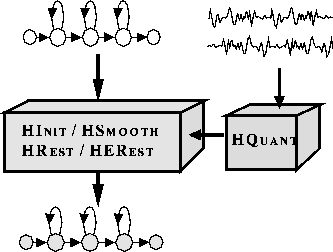
Most of the discussion so far has focussed on using HTK\ to model sequences of continuous-valued vectors. In contrast, this chapter is mainly concerned with using HTK to model sequences of discrete symbols. Discrete symbols arise naturally in modelling many types of data, for example, letters and words, bitmap images, and DNA sequences. Continuous signals can also be converted to discrete symbol sequences by using a quantiser and in particular, speech vectors can be vector quantised as described in section 5.11. In all cases, HTK expects a set of N discrete symbols to be represented by the contiguous sequence of integer numbers from 1 to N.
In HTK discrete probabilities are regarded as being closely analogous to the mixture weights of a continuous density system. As a consequence, the representation and processing of discrete HMMs shares a great deal with continuous density models. It follows from this that most of the principles and practice developed already are equally applicable to discrete systems. As a consequence, this chapter can be quite brief.
The first topic covered concerns building HMMs for discrete symbol sequences. The use of discrete HMMs with speech is then presented. The tool HQUANT is described and the method of converting continuous speech vectors to discrete symbols is reviewed. This is followed by a brief discussion of tied-mixture systems which can be regarded as a compromise between continuous and discrete density systems. Finally, the use of the HTK tool HSMOOTH for parameter smoothing by deleted interpolation is presented.